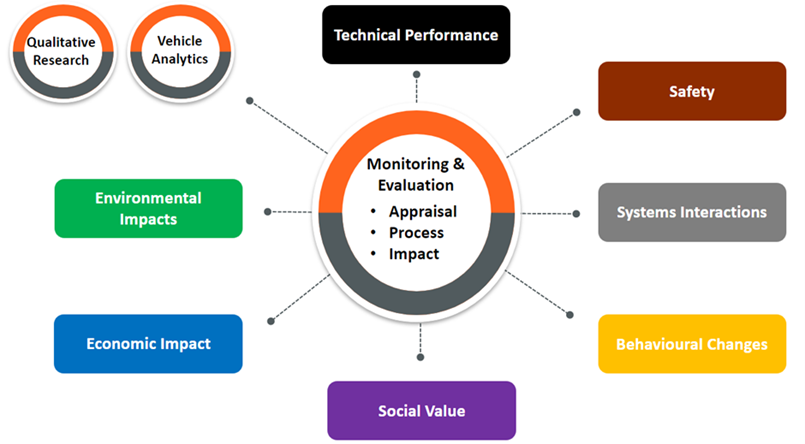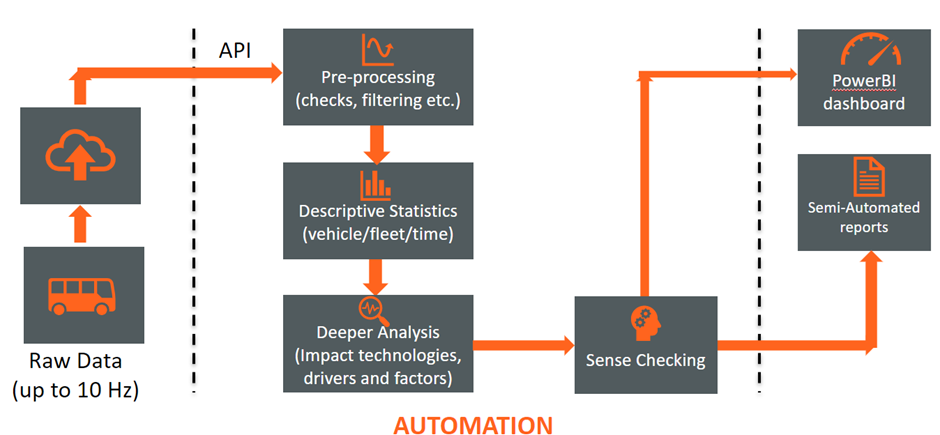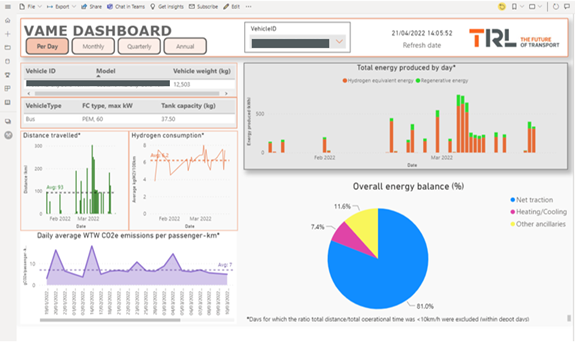The UK government has an ambition of net zero emissions by 2050 and their commitment to a road map for decarbonising transport is crucial to this. From 2030 and 2040, sales of new petrol and diesel cars and heavy-duty fleets respectively, will be phased out. The government is investing to make this happen. For freight this is reflected in the ZERFD (Zero Emissions Road Freight Demonstrations) programme where £200m of funding is available for zero emissions HGVs (battery electric, hydrogen, hybrid battery-fuel cell, and potentially electric road systems). For buses the ZEBRA (Zero Emissions Bus Regional Areas) programme awarded funding worth nearly £170 million, in two phases, to deploy over 1200 zero emission buses in 17 local transport authorities.
TRL’s VAME (Vehicle Analytics Monitoring and Evaluation) platform supports this decarbonisation commitment by making it easier to undertake robust trials and validate commercial claims related to technical performance, safety, greenhouse gas (GHG) emissions, and operational costs of different types of vehicles (Figure 1). Furthermore, by processing raw energy consumption data from vehicles into standard indicators it facilitates monitoring of recharging and refuelling infrastructure. The platform can ground programme and impact evaluations using real-world data, investigating the factors influencing the results and producing robust insights.

Figure 1 VAME can produce insights about performance and reliability, emissions, costs, safety, and behavioural changes.
What is the VAME tool?
VAME is a semi-automated data analytics platform to support monitoring and evaluation of various aspects of vehicle performance during in-service demonstrations and trials. It is cost-efficient as it minimises end-to-end human intervention, from fetching data from the vehicles to producing reports and dashboards. The tool analyses large datasets and enables the like-for-like comparison of vehicles, factoring in the impacts of different duty cycles, drivers’ styles, technologies, and external temperature, applying a consistent approach across vehicle modes.The tool is particularly tailored to support:
- Public sector organisations with responsibility for monitoring and evaluation of large-scale demonstrations of vehicles and infrastructure (buses, HGVs, non-road mobile machinery (NRMM), etc.).
- Logistics operators who want to quantify the impact of a particular low carbon vehicle technology within a vehicle (e.g. by computing the payback period), compare different powertrains within the fleet (e.g. diesel vs electric) or compare the driving performance (with respect to safety and fuel efficiency) of professional drivers.
VAME would also be of benefit to any organisation that needs to quantify the carbon emissions of its vehicle fleet to meet company environmental reporting requirements (e.g. SECR).
The VAME process – More is more!
VAME can help to answer a wide range of questions from assessing the reliability of a zero-emission vehicle, to quantifying the energy savings of a low carbon technology fitted on a vehicle. It does so by accounting for contributory factors (different duty cycles, additional technologies, etc.) so that the energy saving benefit of a particular technology intervention can be identified. The more data provided as an input to the process, the more nuanced the insights can be. A top-level view of the VAME process is shown in Figure 2
Figure 2 VAME automatises the whole end-to-end data workflow, analytics and reporting, minimising human intervention and delivering robust and consistent results
VAME studies
In the development phase, VAME was calibrated with multiple datasets (from buses and HGVs). Recently, the development of VAME was supported by the IUK Hydrogen Transport Hub demonstrations:- Teesside Hydrogen Transport Ecosystem – focusing on hydrogen fuel cell cars, buses and fork-lift trucks.
- Teesside Hydrogen Road2Hydrogen – monitoring a 19t battery electric HGV with a hydrogen fuel cell range extender.
These projects promoted the development and testing of new hydrogen transport technologies and provided an opportunity for TRL to investigate the data collection, transfer and analysis requirements for fuel cell vehicles. Data analysis and reporting was piloted with a hydrogen fuel cell bus.
TRL is also developing a version to monitor and evaluate non-road-mobile machinery (NRMM).
The preliminary results of the demonstrations can be illustrated via PowerBI dashboards (Figure 3), giving monitoring officers frequent insights on the status of the trial. At regular intervals or at the end of the project, a report is produced presenting the results of the demonstration.

Figure 3 Typical VAME PowerBI dashboard.
VAME vision
The VAME process is constantly evolving to deliver a more bespoke and comprehensive analysis process, and to meet new requirements in vehicle monitoring and evaluation as new technologies are employed on and off-road, and in other industries such as rail and shipping. Integrating additional data sources such as topography, energy recovery, and weather data can enable further insights that explain variation in energy consumption. Real-time links to the energy system (smart grids, energy storage, green certificates) can provide more accurate operational costs and GHG emissions. As a flexible tool, the scope for VAME is significant: expanding into new markets such as construction (NRMM, connected and autonomous plant), insurance (safety investigation), predictive analytics (vehicles’ failure), fuel efficient driving training, and mandatory and voluntary carbon reporting (UK-MRV shipping regulations). The VAME roadmap will be evolving to meet clients’ needs and include further transport modes in the coming years.Motorcade project 2023
The Motorcade project has built on the knowledge and insights gained in the initial development of the VAME toolkit, consolidating its initial analytical equations and tools into a coherent framework, and testing this with a range of samples of real-world data. The project has developed standardised metrics for reporting performance in the toolkit and reports these in a Power BI dashboard. The toolkit enables comparison of performance across a range fuel technologies and vehicle types on a common baseline. By applying data from both bus and truck demonstration trials, Motorcade has shown how the VAME toolkit
can be applied to compare fuel, energy (excluding energy demand due to weather), duty cycle, emissions and cost across vehicles using electric and hydrogen technologies. Recommendations are made for a number of refinements that could further improve the capability of the toolkit. Read the report here.

